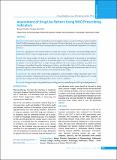Please use this identifier to cite or link to this item:
https://hdl.handle.net/20.500.14356/1545Full metadata record
| DC Field | Value | Language |
|---|---|---|
| dc.contributor.author | Shrestha, Binaya | - |
| dc.contributor.author | Dixit, Sanjaya Mani | - |
| dc.date.accessioned | 2023-05-16T05:26:50Z | - |
| dc.date.available | 2023-05-16T05:26:50Z | - |
| dc.date.issued | 2018 | - |
| dc.identifier.citation | ShresthaB., & DixitS. M. (2018). The Assessment of Drug Use Pattern Using WHO Prescribing Indicators. Journal of Nepal Health Research Council, 16(3), 279-284. https://doi.org/10.33314/jnhrc.v16i3.1208 | en_US |
| dc.identifier.issn | Print ISSN: 1727-5482; Online ISSN: 1999-6217 | - |
| dc.identifier.uri | http://103.69.126.140:8080/handle/20.500.14356/1545 | - |
| dc.description | Original Article | en_US |
| dc.description.abstract | Abstract Background: In order to promote rational drug use in developing countries, assessment of drug use pattern using the World Health Organization drug use indicators is important. The aim of this study was to assess the drug prescription patterns at Kathmandu Medical College Teaching Hospital, using some of the World Health Organization core drug use indicators. Methods: A prospective cross-sectional study was carried out in order to determine current prescribing trends at Kathmandu Medical College Teaching Hospital. A total of 605 prescriptions were collected and analyzed in the study. Results: The average number of drugs per prescription was 5.85 considering the total amount of prescriptions. Furthermore, assuming each prescription as an individual patient, 64.1% of patients received antibiotics, and 71% of patients received injectable form of drugs. Among antibiotics the most common antibiotics prescribed were Ceftriaxone, Amoxicillin/Cloxacillin, Azithromycin, Cefixime, and Cloxacillin. Only 16.94% of the medicines were prescribed in generic names with the rest 83.06% of the medicines being prescribed in brand names and 47.55% of medicines prescribed were from the National List of Essential Medicines-Nepal. Conclusions: The current study revealed that polypharmacy and prescription writing using brand names were common. Prescriptions writing in generic name needs to be promoted and encouraged. There appears to be a crucial need for the development of prescribing guidelines when it comes to antibiotics. Keywords: Drug prescription; drug utilization; prescribing practices; rational drug use; WHO prescribing indicators. | en_US |
| dc.language.iso | en | en_US |
| dc.publisher | Nepal Health Research Council | en_US |
| dc.relation.ispartofseries | Jul-Sep 2018;1208 | - |
| dc.subject | Drug prescription | en_US |
| dc.subject | Drug utilization | en_US |
| dc.subject | Prescribing practices | en_US |
| dc.subject | Rational drug use | en_US |
| dc.subject | WHO prescribing indicators | en_US |
| dc.title | The Assessment of Drug Use Pattern Using WHO Prescribing Indicators | en_US |
| dc.type | Journal Article | en_US |
| local.journal.category | Original Article | - |
| Appears in Collections: | Vol. 16 No. 3 Issue 40 Jul - Sep 2018 | |
Files in This Item:
| File | Description | Size | Format | |
|---|---|---|---|---|
| 1208-Manuscript-6632-1-10-20181030.pdf | Fulltext Article. | 353.56 kB | Adobe PDF |  View/Open |
Items in DSpace are protected by copyright, with all rights reserved, unless otherwise indicated.
